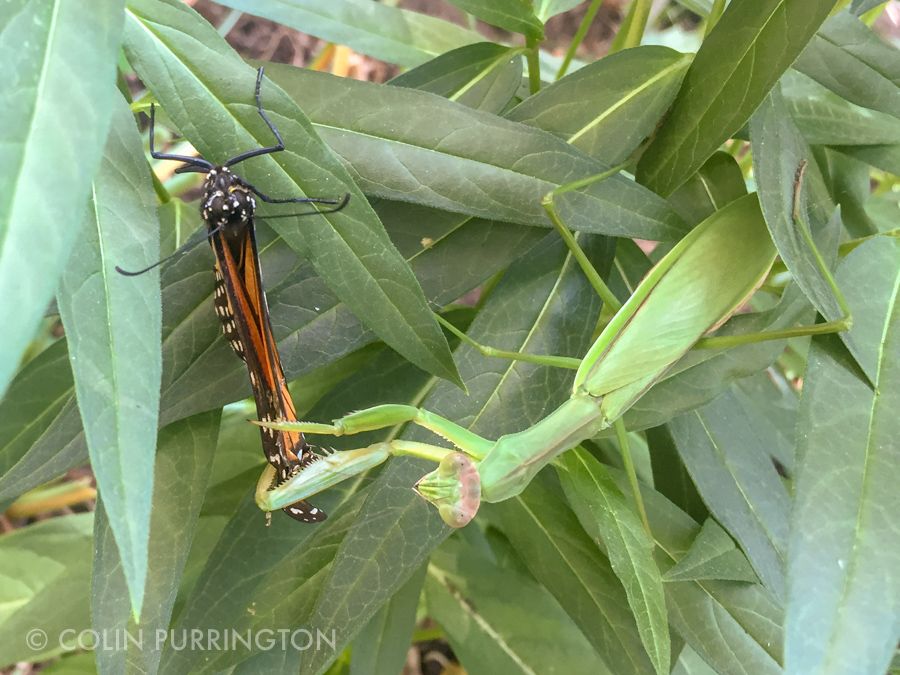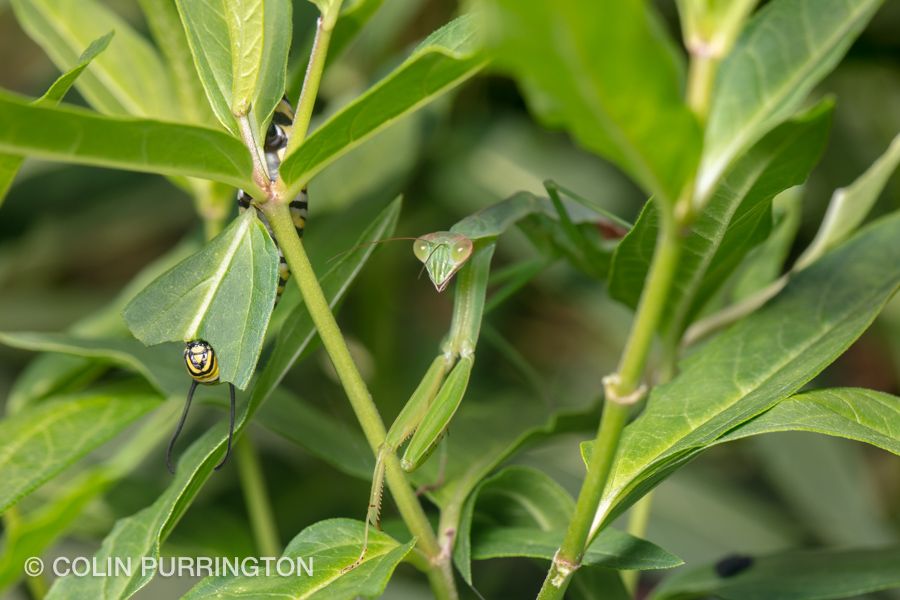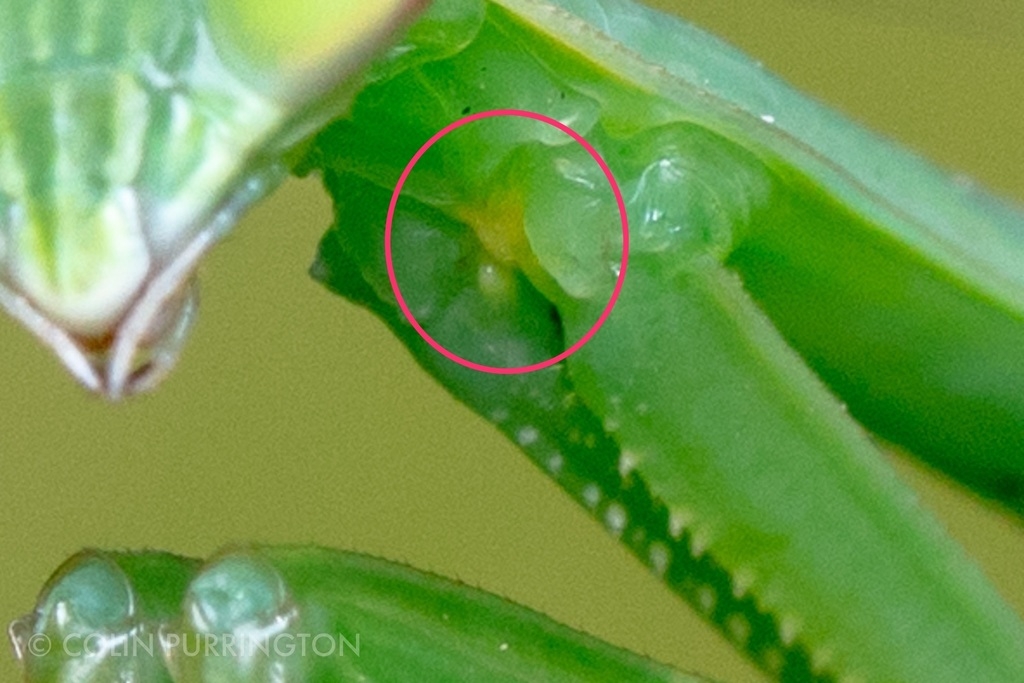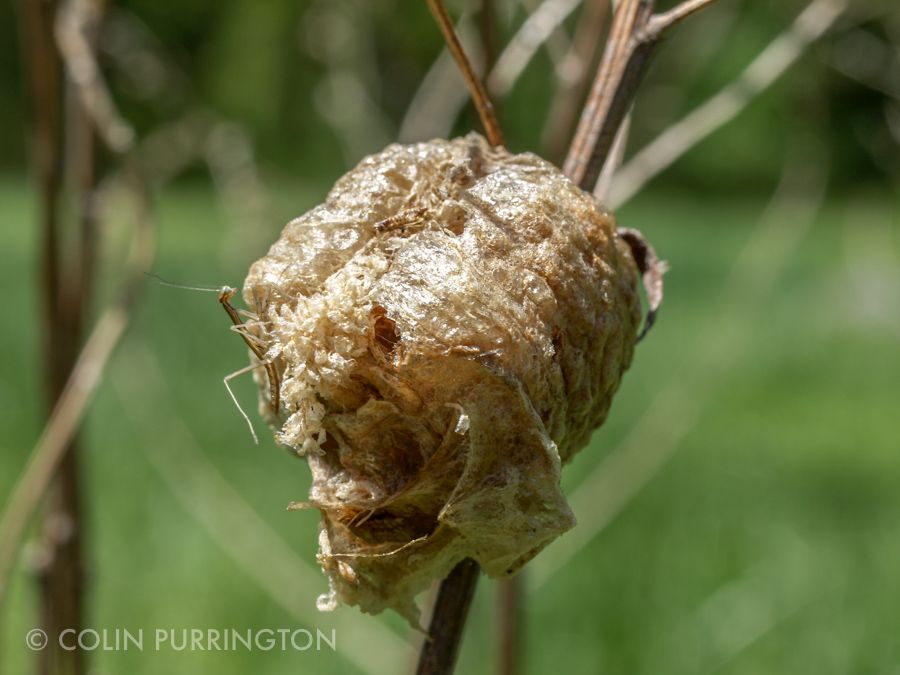This post is a PSA for anyone keen on helping monarchs: if you find Chinese mantids (Tenodera sinensis) in your yard, kill them. As proof, below is a photograph of one that had just snagged a monarch visiting my swamp milkweed. The monarch is fine, by the way. After I intervened she flew off, then came back within seconds and resumed ovipositing.

But unless you’re observing your milkweed patch obsessively, you’ll probably never catch a Chinese mantid in the act. But you can infer their presence by piles of monarch wings (i.e., no body attached). No other animal does this to monarchs.

And caterpillars are just as susceptible. Here’s a Chinese mantid I interrupted just as it was about to strike:

Chinese mantis can be easily distinguished from any of the native mantids by the presence of a yellow dot in between the forelegs.
If you find an ootheca (egg case) of this species, crush it. The oothecae have an irregular, messy surface that looks like a blob of brown, poorly-applied insulating foam. Oothecae of the native Carolina mantis are much smoother and streamlined (see, “Identifying mantid egg cases in Pennsylvania“).
If you’re like most people (including myself), you grew up believing that mantids are a pesticide-free way of reducing garden pests. How could thousands of web sites be wrong?? The truth is, however, that Chinese mantids are so large that they tend to only eat large insects, and that usually means mainly butterflies, not aphids or other species that are tiny. So if you hate butterflies, by all means encourage Chinese mantids in your yard. But if you like butterflies in your garden, kill the Chinese mantids. And don’t just relocate them, even though that seems like the friendly, eco, green, peace-loving thing to do. Moving introduced, invasive species to another location simply facilitates further spread.
FYI, Chinese mantids also eat hummingbirds, plus other birds that are even bigger. The authors of that linked paper conclude,
“Our compilation suggests that praying mantises frequently prey on hummingbirds in gardens in North America; therefore, we suggest caution in use of large-sized mantids, particularly non-native mantids, in gardens for insect pest control.”
Italics mine.



“For example, they have been documented as feeding on small reptiles, amphibians and even small species of hummingbirds.[4][5] Like most mantids, they are known to be cannibalistic. Also like most mantids they do not generally avoid toxic or venomous prey, however they have been observed eating the larvae of monarch butterflies, but discarding the entrails.[6]”
https://www.inaturalist.org/guide_taxa/348934?fbclid=IwAR2txw_xdZLLL25-u0xRbe-1B09J97w_rIvPUWtRExUAlLuOk5qsXPtvWgk#cite_note-6
I caught a Chinese mantid gutting a Monarch caterpillar. I manage them. Now I have native Carolina mantids.
Thanks for getting the word out. Just had a first year male hummingbird killed by one of these nasty invasives. I will do my best to keep them out of my yard.
I totally agree with your opinion and do the same in my gardens. I have worked to make my yard Monarch friendly for many years with tons of Milkweed. Anything to help these gorgeous creatures.
But please, I also work in animal rescue for many years. I hate to see your analogy of a “rabid, aggressive pit bull” as it increases an already hostile opinion of this breed. There are many incredibly sweet and loving pitties and your example does not help. Let’s be respectful and not damage or promote hostility towards dogs of any breed.
I’d looked up pit bulls at the time I wrote that just to double-check my stereotype. It’s apparently part of the breed at baseline, given their original usage. Though I understand one can train an aggressive dog to not be. But I deleted the sentence anyway. Thanks for the suggestion.
The Chinese mantid is a beautiful creature that was imported from China back in 1906. If this creature is invasive, it sure is taking it’s sweet ass time about it. There are over 200 species world wide but they all share a few things in common. Mantis will eat just about any animal it’s own size. They are however triggered by the preys movement. They do not hunt, they lie in wait for their prey to come along, which is why I call BS on people claiming they eat humming birds. The YouTube videos showing a hummingbird attacked by a mantis hanging on a bird feeder are staged by the camera man for his personal financial gain. The mantids diet mostly consists of roaches, crickets, spiders, grasshoppers, and just about all plant eating insects to include caterpillars. All the haters of this animal may not care but If you want to stop killing Monarchs, ease off the pesticides in your garden. Birds such as black-backed orioles and black-headed grosbeaks are common predators at monarch overwintering sites. These species can eat large quantities of monarchs without getting poisoned. Then again, maybe we should stop deciding which creatures are allowed to live based on their beauty. Haters are gonna hate, but if you want the real scoop, consult an entomologist.